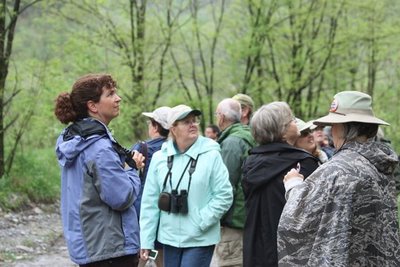 It usually rains at the end of April and beginning of May in West Virginia. When I was corresponding with other members of the nature blogging Flock about the trip, I advised raingear, lots of it. And this turned out to be a very wet festival.
It usually rains at the end of April and beginning of May in West Virginia. When I was corresponding with other members of the nature blogging Flock about the trip, I advised raingear, lots of it. And this turned out to be a very wet festival.Which was something to deal with, but not a problem. People who love warblers are happy folks. They kept their sunny attitude.
The flowers were still lovely. Golden ragwort and cranesbill (wild geranium).
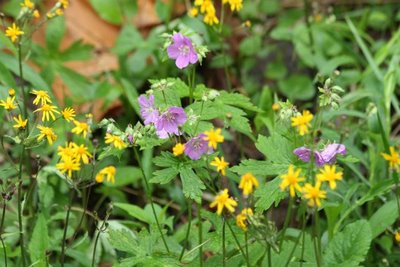 The magnificent large tree, Fraser magnolia, Magnolia fraseri.
The magnificent large tree, Fraser magnolia, Magnolia fraseri.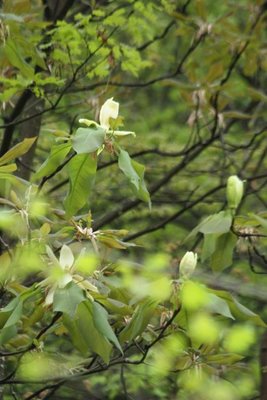 The birds' colors were a bit compromised by the fog and rain. In sunlight, cerulean warblers are sky blue.
The birds' colors were a bit compromised by the fog and rain. In sunlight, cerulean warblers are sky blue.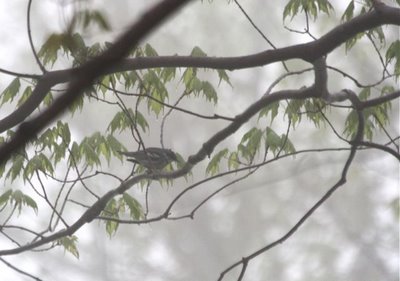
They still sang, if a little less persistently. Their black necklaces were all that distinguished them; their stunning blue backs would have to wait for better light, better days.
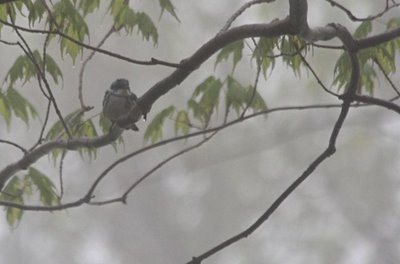
It was all very ricepaper and watercolor, very Japanese. Even a male scarlet tanager looked grayish in this light.
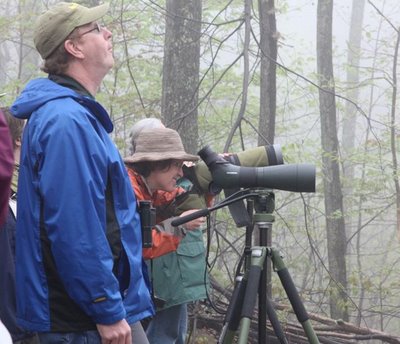 Well, it's shaped like a tanager... Photo by Nina.
Well, it's shaped like a tanager... Photo by Nina.The direction of light became paramount in getting a decent look at a bird. This northern parula cooperated for a nanosecond, showing his sunny breast.
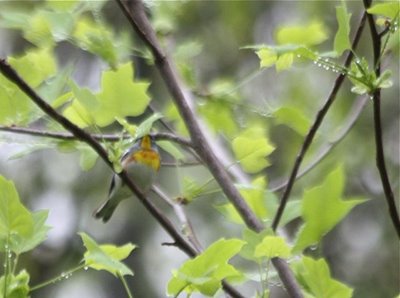 As we walked, I noticed a female eastern towhee as she burst frantically from the ground. She appeared to have been trying to stay still, then lost her nerve. I knew that meant she was on eggs somewhere nearby. I split from the group and walked carefully along the foot of the bank.
As we walked, I noticed a female eastern towhee as she burst frantically from the ground. She appeared to have been trying to stay still, then lost her nerve. I knew that meant she was on eggs somewhere nearby. I split from the group and walked carefully along the foot of the bank.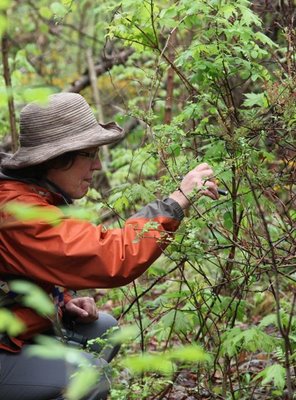 And found the nest, using a laser pointer to show it to the festival participants. Photo by Nina.
And found the nest, using a laser pointer to show it to the festival participants. Photo by Nina.Four white eggs, speckled with rust, well hidden in a grassy nest tucked into the bank, under a big multiflora rose. I wish her well.
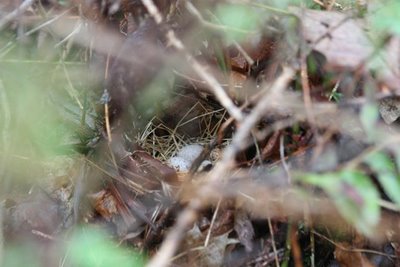
Some black rat snake eggs were less fortunate. Examining these, I decided that they had been washed out after having been buried by the female snake last summer. The eggshells were unpunctured, but there was nothing inside. So it wasn't a predation event--it was a dessication event.
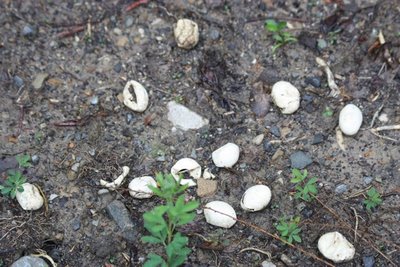
Red efts (the wandering, terrestrial, juvenile form of the red-spotted newt) were easier subjects than birds.
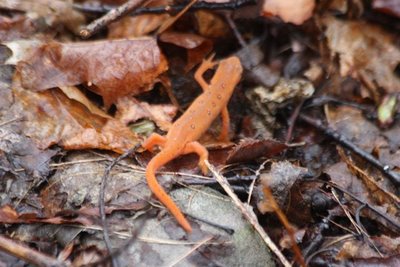 The smallest red eft I'd ever seen enchanted Nina. I'm sure he'll make an appearance on her blog, Nature Remains.
The smallest red eft I'd ever seen enchanted Nina. I'm sure he'll make an appearance on her blog, Nature Remains.Katdoc joined her in the photoquest. Katdoc is geared out, full birding plumage.
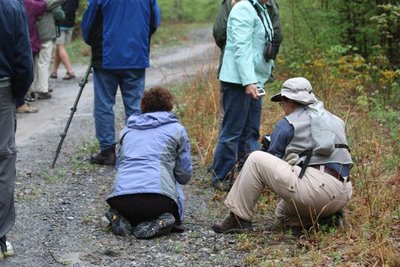 Nina has ferocious focus.
Nina has ferocious focus.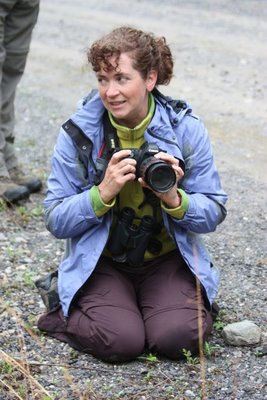 She folded up like a tripod and became one with the newt.
She folded up like a tripod and became one with the newt.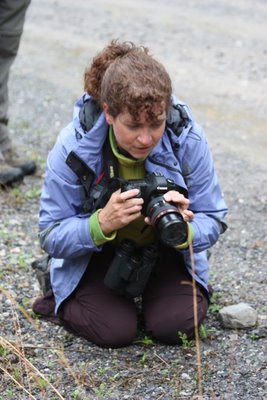
One of Nina's many gifts is looking very closely, and waiting.
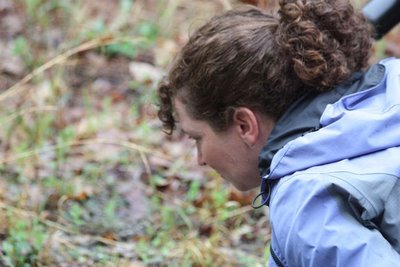
Everyone moved on, which is just what Nina needed.
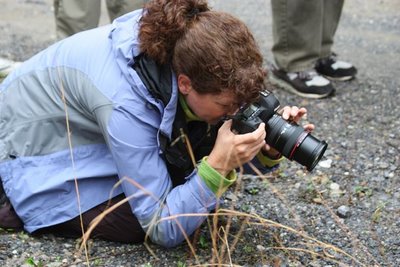 And she became a rock in the road, and captured the eft without touching it.
And she became a rock in the road, and captured the eft without touching it.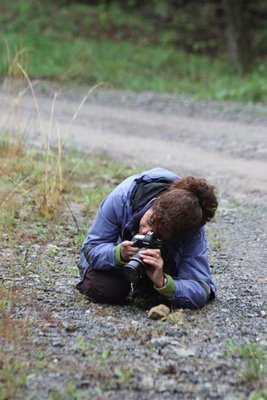
As Nina and I walked the last bit of Spruce Run Road, loosely known at the festival as Muddlety, we marveled at the abundant life all around us--prairie and blue-winged warblers, chat after yellow-breasted chat, redstarts and hooded warblers, the federally threatened cerulean warbler, scarlet tanagers, and everywhere the flutes of wood thrushes. A tear coursed down Nina's cheek, then another. We had both seen the coal company permit sign about halfway up the road, that, to those who know its significance, means that this entire woodland--all this habitat, all this mountain--is about to be blown up, never to be woodland habitat again.
When you flip a light switch on, there's a 50 percent chance that the energy you're using comes out of what used to be a mountain in West Virginia. Blowing up the richest and most diverse forest in the US--leveling these mountains-- to get the coal underneath it is not a sustainable way to get energy. It is insanity itself. It buries the streams, chokes the rivers and poisons the people. Please, please watch this five-minute video. Maria Gunnoe says it so much better than I ever could. And if you're moved to action, go to the Ohio Valley Environmental Coalition web site and see what you can do to stop this abomination. Muddlety probably won't survive, but there are so many more equally beautiful mountains--and communities, streams, rivers and lives-- the coal companies are planning to destroy.
Watch, then go. Keep spending your ecotourism dollars in West Virginia. All profits from the New River Birding Festival go to environmental education in local schools--a slow but, we hope, ultimately effective way to shout STOP THIS MADNESS!! Thank you.
And thank you, Cassandra.






17 comments:
A few of us ran into a woman at the Charleston airport who was on her way to Anchorage to share information about mountaintop removal. It's to begin there too.
I've been to the New River Valley many, many times rafting the river. It's a lovely, magical area. I agree wholeheartedly that we need to add our collective voices to stop mountaintop coal removal. It's an abomination on our land.
Julie, your link to the Ohio River Valley coalition (not sure that's exactly the right name) doesn't work.
Stefanie Graves
The link wouldn't work, but I found the Web site anyway. Thanks.
Another great Web site dedicated to stopping mountain top removal is
http://www.ilovemountains.org. There are links there to communicate with legislators and updates on all pending bills. The site also has a nice story about Maria Gunnoe and her efforts.
Seeing the lovely West Virginia wildlife should stimulate all of us to become more active.
Not only does this provoke tears, it's an insanity I can't begin to understand. I hate the thought of Muddelty and all the lovely plants and animals there completely gone.
The day I was at the giant poplar tree, the forest was being logged. We stood by the tree and hugged it as a group, while we listened to chainsaws roar and trees fall and crash.
Muddlety is etched in my mind.
Probably the prettiest place I saw all week--which just made the future of that mountain and all who call it home all the more heartbreaking.
Decisions made behind closed doors and around boardroom tables must be far easier than those considered in the midst of such a place.
Yes, I have pictures of the brilliant beauty, daring to emerge from those deep, wet woods and cross our path.
Still struggling to do him justice--poor little soul.
Muddlety was my Best Day Outside Ever.
To think of it being destroyed...I'm in a rage.
RAGE.
I wept on those hillsides. I held a newt who was intent on running up my chest to my neck. I marveled at British Soldier lichen. I sighed at the pipevine swallowtails.
RAGE.
Cargo pants, photog's vest, and a weird hat. Yep, that's me, with all my field marks.
So sad to think of that beautiful place being blown into smithereens. Who will protect the nesting towhees, singing warblers, and teeny tiny efts?
~kathi
All of that and what we saw and heard during our lunch at Muddlety - chain saws and trees falling all around us. It was disgusting.
It needs to remain as lovely...
Thanks for mentioning the ilovemountains site; it is a great one, as is the West Virginia Highlands Conservancy website at http://www.wvhighlands.org
The Ohio Valley Environmental Coalition site is at http://www.ohvec.org
Rage, yes — grief, horror, and disbelief, often. I'm totally overwhelmed on a daily basis. But none of it does any good unless it galvanizes us into action. WE must protect the nesting towhees, singing warblers,and the efts — or no one will. No one.
Thank you so much, Julie Z!
Sad to say that many of those board room execs visit those incredible places and still make those decisions. We are the only ones who can hope to change it -- we just have to use our power as consumers and citizens; it has to be part of us like breathing is.
Ain't no such thing as clean coal. Thanks, Julie.
Thank you Julie for this post. I have not been able to stop thinking about that horrid sign nailed to the tree.
We must raise our voices.
Those last few grafs hit me like a kick in the stomach, Julie, but that news has to get out. I know that our efforts to stop this abomination are having some effect, but we all need to keep on fighting, keep on calling and emailing and writing to our lawmakers.
The thought of Muddlety being gone before I can even see it--there's that kick in the gut again.
I finished reading this post with tears in my eyes too. It's just so sad that so much of this area is being destroyed.
Julie, I think John Denver would be proud that you used his modifed lyrics for the title to this post. I had no idea that day were were at Muddlety that that whole mountaintop would be removed someday. How sad it is to think of all the wildlife habitat that will be lost and all the earth and around it poisoned. I hope and pray that we as a nation will soon come to our senses and stop this madness. I watched the video. That is one brave woman. I think you are on the right track educating children about the environment. I hope the coming generations will be wiser and more thoughtful about how we walk on this land.
Here in Costa Rica we had an issue abut a foreign gold company that wanted to build a huge, open-pit gold mine in the area of Crucitas, located in northern Costa Rica. The area was filled with the endangered "almendro amarillo" (forgive me I don't know how to translate the name), a protected type of tree that provides critical habitat to the endangered Green Macaw. The public went crazy. People rallied and protested, they held banners and seeing people with bumper stickers that said "Costa Rica NO quiere minería a cielo abierto!" (Costa Rica DOES NOT want open-pit mining!).
Huge, 200 km walks were organaized. Hundreds of people walked from the capital to the area where the project would take place. I wished i coulad have participated in it!
After almost a year of dealing with this, the court finally made a intelligent decision--they stopped all operations in the area and began a long research on the president that had allowed the project, for he without telling nothing to the public said it was of "public interest". Now, all operations have stopped there and a new bill that forever prohibits any mining operations in the rich lands of Costa Rica has been approved, for the real natural value of a natural area is not its coal, gold or any other of that kind of resources that want to be exploited, but instead what makes it rich are its fauna and flora, the real value we must all protect.
I read your article about this in BWD, and I was completely horrified by this. Worst thing is, they then say it is "Clean Coal". I am a young Costarrican birder, and I completely support your views about this, Julie.
Forgive me for my English.
Cristina, I am so glad you wrote to comment. Knowing that what coal companies are doing to our mountains horrifies you as Costa Rican provides a good perspective for everyone here. We must not stop crying out about such idiotic things as mountaintop removal mining, no matter where it occurs. The truth is that there are many people who will happily destroy everything for one-time gain. They will never see what crime they commit--it is up to us to show it to the rest of the world.
Please don't apologize for your English. It's perfect, and so is the passion behind your story.
It just slays me lately--all these PR ads for "clean coal"--there's nothing clean about any aspect of it!
Post a Comment